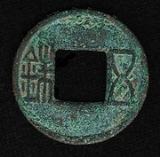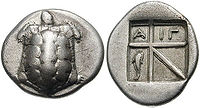
History of coins
Encyclopedia



Coin
A coin is a piece of hard material that is standardized in weight, is produced in large quantities in order to facilitate trade, and primarily can be used as a legal tender token for commerce in the designated country, region, or territory....
s extends from ancient times to the present, and is related to economic history
Economic history
Economic history is the study of economies or economic phenomena in the past. Analysis in economic history is undertaken using a combination of historical methods, statistical methods and by applying economic theory to historical situations and institutions...
, the history of minting
Mint (coin)
A mint is an industrial facility which manufactures coins for currency.The history of mints correlates closely with the history of coins. One difference is that the history of the mint is usually closely tied to the political situation of an era...
technologies, the history shown by the images on coins, and the history of coin collecting
Coin collecting
Coin collecting is the collecting or trading of coins or other forms of minted legal tender.Coins of interest to collectors often include those that circulated for only a brief time, coins with mint errors and especially beautiful or historically significant pieces. Coin collecting can be...
. Coins are still widely used for monetary and other purposes.
All western histories of coins begin with their invention at some time slightly before or after 700 B.C. in Aegina
Aegina
Aegina is one of the Saronic Islands of Greece in the Saronic Gulf, from Athens. Tradition derives the name from Aegina, the mother of Aeacus, who was born in and ruled the island. During ancient times, Aegina was a rival to Athens, the great sea power of the era.-Municipality:The municipality...
Island, or according to others in Ephesus
Ephesus
Ephesus was an ancient Greek city, and later a major Roman city, on the west coast of Asia Minor, near present-day Selçuk, Izmir Province, Turkey. It was one of the twelve cities of the Ionian League during the Classical Greek era...
, Lydia
Lydia
Lydia was an Iron Age kingdom of western Asia Minor located generally east of ancient Ionia in the modern Turkish provinces of Manisa and inland İzmir. Its population spoke an Anatolian language known as Lydian....
, 650 B.C.
Since that time, coins have been the most universal embodiment of money
Money
Money is any object or record that is generally accepted as payment for goods and services and repayment of debts in a given country or socio-economic context. The main functions of money are distinguished as: a medium of exchange; a unit of account; a store of value; and, occasionally in the past,...
. These first coins were made of electrum
Electrum
Electrum is a naturally occurring alloy of gold and silver, with trace amounts of copper and other metals. It has also been produced artificially. The ancient Greeks called it 'gold' or 'white gold', as opposed to 'refined gold'. Its color ranges from pale to bright yellow, depending on the...
, a naturally occurring pale yellow mixture of gold and silver that was further alloyed with silver and copper.
Also, the Persian coins were very famous in the Persian and Sassanids era. Most notably, in Susa
Susa
Susa was an ancient city of the Elamite, Persian and Parthian empires of Iran. It is located in the lower Zagros Mountains about east of the Tigris River, between the Karkheh and Dez Rivers....
and in Ctesiphon
Ctesiphon
Ctesiphon, the imperial capital of the Parthian Arsacids and of the Persian Sassanids, was one of the great cities of ancient Mesopotamia.The ruins of the city are located on the east bank of the Tigris, across the river from the Hellenistic city of Seleucia...
.
Some of the most famous and widely collected coins of antiquity are Roman coins
Roman currency
The Roman currency during most of the Roman Republic and the western half of the Roman Empire consisted of coins including the aureus , the denarius , the sestertius , the dupondius , and the as...
and Greek coins.
The Byzantine Empire
Byzantine Empire
The Byzantine Empire was the Eastern Roman Empire during the periods of Late Antiquity and the Middle Ages, centred on the capital of Constantinople. Known simply as the Roman Empire or Romania to its inhabitants and neighbours, the Empire was the direct continuation of the Ancient Roman State...
minted many coins (see Byzantine currency), including very thin gold coins bearing the image of the Christian
Christian
A Christian is a person who adheres to Christianity, an Abrahamic, monotheistic religion based on the life and teachings of Jesus of Nazareth as recorded in the Canonical gospels and the letters of the New Testament...
cross and various Byzantine emperors.
A tomb of the Shang Dynasty
Shang Dynasty
The Shang Dynasty or Yin Dynasty was, according to traditional sources, the second Chinese dynasty, after the Xia. They ruled in the northeastern regions of the area known as "China proper" in the Yellow River valley...
dating back to the 11th century B.C. shows what may be the first cast copper money Tong Bei
Tong Bei
Tong Bei literally translated as "Bronze Cowry" or "Bronze Shell", is an ancient coin found in China. This coin itself is a replica of more ancient Cowry Money, made for the purpose of replacing it.-External links:*...
. Coinage was in widespread use
Economy of the Han Dynasty
The Han Dynasty of ancient China experienced contrasting periods of economic prosperity and decline. It is normally divided into three periods: Western Han , the Xin Dynasty , and Eastern Han . The Xin Dynasty, established by the former regent Wang Mang, formed a brief interregnum between lengthy...
by the Warring States Period
Warring States Period
The Warring States Period , also known as the Era of Warring States, or the Warring Kingdoms period, covers the Iron Age period from about 475 BC to the reunification of China under the Qin Dynasty in 221 BC...
and the Han Dynasty
Han Dynasty
The Han Dynasty was the second imperial dynasty of China, preceded by the Qin Dynasty and succeeded by the Three Kingdoms . It was founded by the rebel leader Liu Bang, known posthumously as Emperor Gaozu of Han. It was briefly interrupted by the Xin Dynasty of the former regent Wang Mang...
.
Some of the earliest coins were beaten at the edges to imitate the shape of a cow, in indication of their value. Most coins are circular but some were rectangular. Also a lot of coins, especially in China had a hole through the center so they could be tied on to a string.
Some of the earliest coins to be made purely from silver
Silver
Silver is a metallic chemical element with the chemical symbol Ag and atomic number 47. A soft, white, lustrous transition metal, it has the highest electrical conductivity of any element and the highest thermal conductivity of any metal...
and gold
Gold
Gold is a chemical element with the symbol Au and an atomic number of 79. Gold is a dense, soft, shiny, malleable and ductile metal. Pure gold has a bright yellow color and luster traditionally considered attractive, which it maintains without oxidizing in air or water. Chemically, gold is a...
were the silver Dirham
Dirham
Dirham or dirhem is a unit of currency in several Arab or Berber nations, and formerly the related unit of mass in the Ottoman Empire and Persian states...
and gold Dinar
Gold Dinar
The gold dinar is a gold coin first issued in 77 AH by Caliph Abd al-Malik ibn Marwan. The name is derived from denarius, a Roman currency...
in the early Islamic Caliphate
Caliphate
The term caliphate, "dominion of a caliph " , refers to the first system of government established in Islam and represented the political unity of the Muslim Ummah...
from the 7th century.
Minting technologies
.jpg)
Hammered coinage
Hammered coinage is the most common form of coins produced since the invention of coins in the first millennium BC until the early modern period of ca...
positioned over an anvil
Anvil
An anvil is a basic tool, a block with a hard surface on which another object is struck. The inertia of the anvil allows the energy of the striking tool to be transferred to the work piece. In most cases the anvil is used as a forging tool...
. The Chinese produced primarily cast coinage
Cast coinage
Cast coinage refers to coins made by pouring melted metal into a mold, i.e. casting. It has been used for regular coins, particularly in the Far East, but also on a smaller scale. The method differs from the current mode of coin production, which is done by striking coin blanks that have been cut...
, and this spread to South-East Asia and Japan. Relatively few non-Chinese cast coins were produced by governments, however it was a common practice amongst counterfeit
Counterfeit
To counterfeit means to illegally imitate something. Counterfeit products are often produced with the intent to take advantage of the superior value of the imitated product...
ers. Since the early 18th century and before, presses (normally referred to as mills in coin collecting circles) have been used in the west, beginning with screw presses and progressing in the 19th century towards steam driven presses. The first of these presses were developed in France and Germany, and quickly spreading to Britain. Recently modern minting techniques involving electric and hydraulic presses have been more commonly employed.
The type of mintage method (being hammered, milled or cast) does limit the materials which can be used for the coin. For example antimony
Antimony
Antimony is a toxic chemical element with the symbol Sb and an atomic number of 51. A lustrous grey metalloid, it is found in nature mainly as the sulfide mineral stibnite...
coins, (which are very rare) are nearly always cast examples, because of the brittle nature of the metal, and thus it would break if deformed, which is a key part of the milling or hammering process.
External links
- World Coin Gallery - Self-proclaimed largest coin site in the world, with over 10,000 coins
- http://www.worldcoins.ws/ world coin collectors site for
- 中国造币--钱币鉴赏("Chinese made coins-seeing coins", site in Simplified Chinese about Chinese coins)
- Ancient Greek Coins: Free Coin Organizer
- Museum of Bank notes and Coins(in Japanese)

